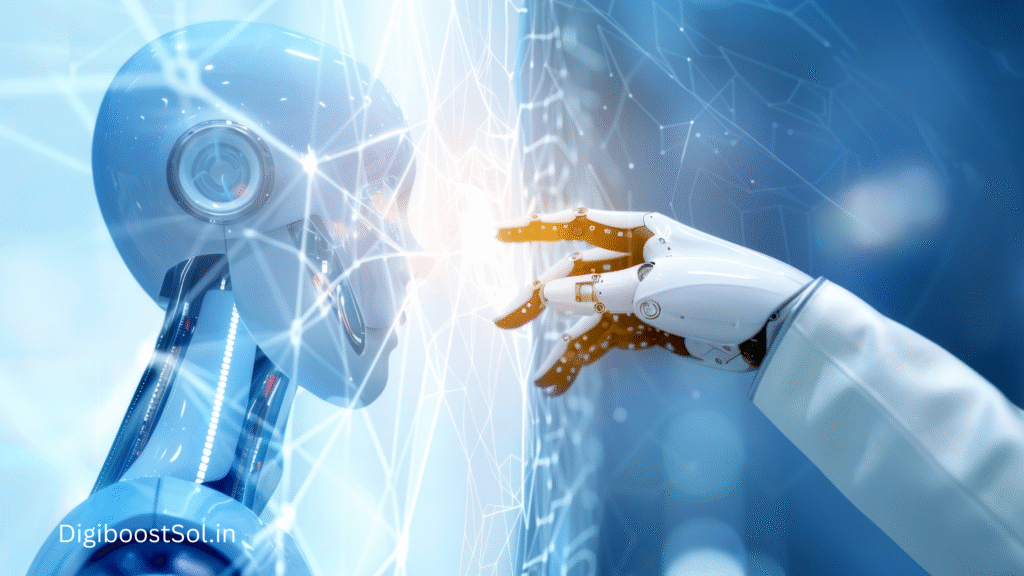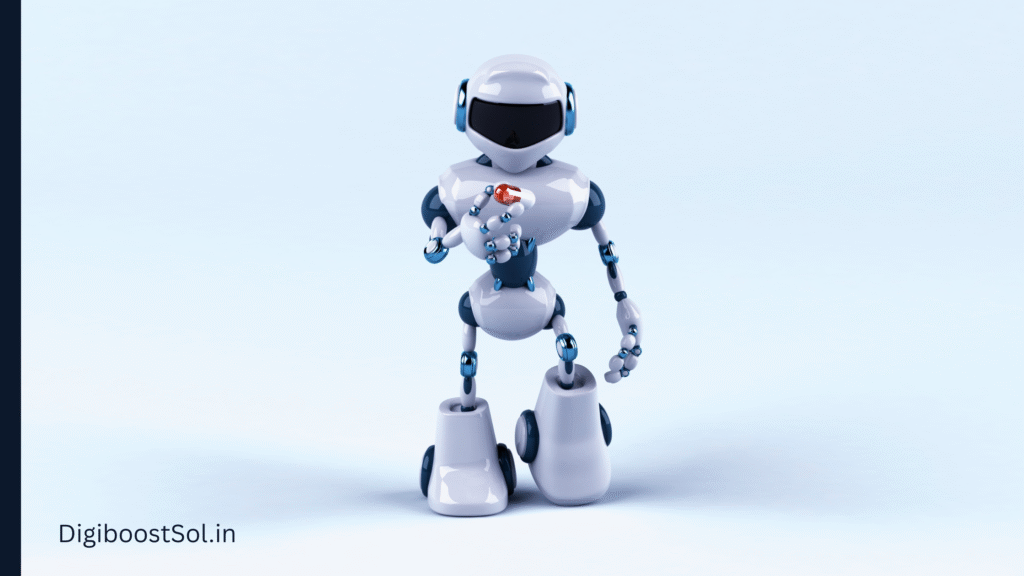How AI Will Improve Robots in the Future


Introduction
In today’s world, technology is changing very fast. One of the biggest reasons for this change is Artificial Intelligence (AI). Another amazing invention is robots. When AI and robots come together, they can do powerful things.
In this article, we will explore how AI will improve robots in the future, how it will impact our lives, and what new things we can expect from this combination.
What is Artificial Intelligence (AI)?
AI is a technology that allows machines to think and make decisions like humans. It learns from data, understands language, solves problems, and improves with experience.
Example:
- Google Assistant answers your questions.
- YouTube is recommending videos.
- ChatGPT writing essays or solving doubts.
These all use AI.
What are Robots?
Robots are machines that can perform tasks automatically. They can move, sense, and act based on commands.
Some robots are:
- Industrial robots – used in factories.
- Service robots – used for cleaning or deliveries.
- Medical robots – used in hospitals for surgery.
- Humanoid robots – that look like humans and talk.
Role of AI in Robots
AI gives a “brain” to robots. Robots already have bodies, sensors, and motors. But with AI, they can:
- Think and make decisions.
- Understand speech and images.
- Learn from mistakes.
- Work without human control.
Without AI, robots are just remote-controlled machines. But with AI, they become smart machines.
How AI Will Improve Robots in the Future?
Let’s look at how AI will make robots smarter, faster, and more helpful in the future.
1. Better Understanding of Environment
In the future, AI-powered robots will have:
- Advanced sensors and cameras.
- AI that helps them understand their surroundings like humans.
They will:
- Avoid obstacles.
- Recognize people and objects.
- Work in different weather and light conditions.
Example: A robot vacuum cleaner will understand dirty areas better and clean more smartly.
2. Voice and Language Understanding
AI will help robots:
- Understand human speech in many languages.
- Answer questions using natural language.
Robots will talk like friends, not just follow commands.
Example:
- You say: “Robot, please bring me a glass of water.”
- It will understand your voice and bring water from the kitchen.
3. Learning from Experience
Future robots will use machine learning to:
- Learn from past actions.
- Improve their performance.
- Avoid repeating mistakes.
Just like humans become smarter with practice, robots will also become better every day.
4. Facial and Emotion Recognition
AI will help robots:
- Recognize faces.
- Understand human emotions from voice and expressions.
This will make robots more friendly and helpful.
Example: If a robot sees you sad, it might play a happy song or talk kindly.
5. Faster and Safer Decision Making
In factories, hospitals, and public places, robots need to act fast.
AI will:
- Help robots make quick decisions.
- Ensure safety for humans around them.
Example: In case of fire, robots can guide people to safety using AI decisions.
6. Human-like Movements
AI with robotics will improve:
- Hand and leg movements.
- Walking, running, climbing stairs, using tools, etc.
Humanoid robots will move more smoothly and naturally, just like real people.
7. More Independence
In the future, robots will need fewer human instructions. They will:
- Plan their tasks.
- Manage time.
- Charge themselves.
- Ask for help only when needed.
This will make them perfect helpers at home, office, in hospitals, and on farms.
Real-World Examples of AI Robots (Already in Use)
1. Tesla Bot (Optimus)
- Humanoid robot by Tesla.
- Can walk, carry items, and understand voice commands.
2. Pepper Robot
- Can talk, show emotions, and interact with people.
- Used in malls, banks, and airports.
3. Surgical Robots
- Help doctors perform operations with high accuracy.
- AI helps reduce mistakes and recovery time.
4. Warehouse Robots (Amazon)
- Move products in large warehouses using AI navigation.
- Save time and increase the speed of delivery.
Where Will AI Robots Be Used in the Future?
1. Healthcare
- Robot nurses to care for the elderly.
- AI doctors for remote villages.
- Surgery robots with 99% accuracy.
2. Education
- Robots as personal tutors.
- Teach students based on their learning speed.
- Help in remote or poor areas.
3. Home Help
- Cooking, cleaning, and taking medicines.
- Taking care of kids or the elderly.
- Security robots for home safety.
4. Agriculture
- Robots to plant, water, and harvest crops.
- Detect plant diseases using AI.
5. Disaster Management
- Robots can enter dangerous zones (fire, flood, earthquake).
- Save lives and send real-time updates to rescue teams.
Benefits of AI-Powered Robots
- 🧠 Smarter and more useful machines.
- ⏱️ Save time and energy.
- 🧓 Help for old and disabled people.
- 🧼 Perform dangerous or dirty jobs.
- 🚀 Improve speed and safety in industries.
Challenges Ahead
- Cost – AI robots are expensive to build and maintain.
- Job Loss – Some manual jobs may be reduced.
- Ethics – Should robots make life decisions?
- Security – Risk of hacking or misuse.
These challenges need smart policies and human control.
Will Robots Replace Humans?
No, robots will not fully replace humans.
- Robots can work with humans, not instead of them.
- Humans have creativity, emotions, and ethics – robots don’t.
- AI robots are tools to assist and support us.
Conclusion
The future of AI and robots is full of possibilities. AI will make robots:
- Smarter
- Faster
- Safer
- More helpful
They will help us at home, work, school, hospitals, and everywhere. But we must use them wisely and responsibly.
Robots and humans can together build a better future – where technology supports life, not controls it.


